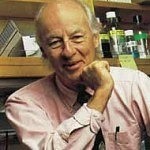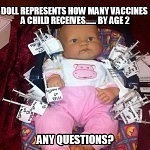Biotechnology has long tried to paint the critics of genetic engineering as anti-science. A great effort has been made to convince the public that the majority of world’s scientists support genetic engineering. In reality, GMOs are heavily criticized in the scientific community. Here are the professional opinions of only a few of the thousands of scientists who are both critical and skeptical of GMOs.
There are three things that can’t be long hidden: the sun, the moon and the truth.” – Buddha
 Vandana Shiva, Ph.D
Vandana Shiva, Ph.D
Vandana Shiva was educated as physicist at the University of Punjab. Afterwards she went on to earn a Ph.D. from the University of Western Ontario Canada. Her field of study was known as “Hidden Variables and Non-locality in Quantum Theory”. Her work later evolved into inter-disciplinary research in science, technology, and environmental policy. Dr. Shiva is a courageous and tireless activist, author, scientific advisor, and mother. Forbes Magazine named Dr. Shiva as one of the Seven Most Powerful Women in the World.
Science is derived from the word scire — “to know”. Each of us should know what we are eating, how it was produced and what impact it will have on our health.
The knowledge we need for growing food is the knowledge of biodiversity and living seed, of living soil and the soil food web, of interaction between different species in the agro-ecosystem and of different seasons. Farmers have been the experts in these fields, as have ecological scientists who study the evolution of micro-organisms, plants and animals, the ecological web and the soil food web.
In industrial agriculture, the knowledge of living systems is totally missing, since industrial agriculture was externally driven by using war chemicals as inputs. Soil was defined as an empty container for holding synthetic fertilizers and plants were defined as machines running on external inputs. This meant substituting the ecological functions and services that nature and farmers can provide through renewal of soil fertility, pest and weed control, and seed improvement. But it also implied ignorance of the destruction of the functions by the toxic chemicals applied to agriculture.
This complex knowledge of interacting, self-organizing, self-maintaining, self-renewing and self-evolving systems that farmers have had is now being confirmed through the latest in ecology. At the agricultural systems level, agro-ecology, not the mechanistic and blind paradigm of industrial agriculture is the truly scientific approach to food production.
…Because living systems are not machines, they are a self-organized complexity, knowledge of a small, fragmented part in isolation of its relationships with the rest of the system translates into not knowing.
This epistemic violence is now being combined with the violence of corporate interests to viciously attack all scientific traditions, including those that have evolved from within Western science and transcended the mechanistic worldview.
It is actually becoming anti-science.
…The rhetoric for taking over food systems and seed supply is always based on “improved seed”. But what is not mentioned is that industrial seeds are only “improved” in the context of higher dependence on chemicals, and more control by corporations.
The latest in the anti-scientific discourse of industrial agriculture is about reducing everything to genetically modified organisms (GMOs).
“Intelligence” is based on the Latin word inter legere which means “to choose”. From the slime mould and bacteria, to plants and animals, including humans, intelligence is the choice we make in order to respond to changing contexts. Life is a cognitive system with communication constantly taking place in a network on non-separable patterns of relationship. Living beings innovate all the time to deal with environmental challenges that face them.
…Humans as a species are falling behind slime mold and bacteria to make an intelligent response to the environmental threats we face. And our intelligence is being thwarted by the false construction of the living Earth as dead matter, to be exploited limitlessly for human control, domination and greed.
The US Centre for Disease Control data shows that on current trends one in two children in the US will be autistic in a few decades. It is not an intelligent species that destroys its own future because of a distorted and manipulated definition of science.
As Einstein had observed, “Two things are infinite: the universe and human stupidity and I’m not sure about the universe.”
Thierry Vrain, Ph.D
Dr. Vrain was formerly the Head of Biotechnology at Agriculture Canada’s Summerland Research Station. It was his job to address concerns regarding the safety of GMOs. He did his job faithfully for many years, assuring the public and other scientists of the safety of GMOs. Now, years after his retirement, he has reversed his position.
In the last 10 years I have changed my position. I started paying attention to the flow of published studies coming from Europe, some from prestigious labs and published in prestigious scientific journals, that questioned the impact and safety of engineered food.
I refute the claims of the biotechnology companies that their engineered crops yield more, that they require less pesticide applications, that they have no impact on the environment and of course that they are safe to eat.
…The Bt corn and soya plants that are now everywhere in our environment are registered as insecticides. But are these insecticidal plants regulated and have their proteins been tested for safety? Not by the federal departments in charge of food safety, not in Canada and not in the U.S.
Genetic engineering is 40 years old. It is based on the naive understanding of the genome based on the One Gene – one protein hypothesis of 70 years ago, that each gene codes for a single protein. The Human Genome project completed in 2002 showed that this hypothesis is wrong.
 Richard Strohman, Ph.D.
Richard Strohman, Ph.D.
Dr. Richard Campbell Strohman, was a professor emeritus of molecular and cell biology at the University of California, Berkeley. He was an avid critic of the idea that genes determine destiny. Dr. Strohman died July 4, 2009.
When you insert a single gene into a plant or an animal, the technology will work. You will be able to move that gene from organism A to organism B. You will be able to know that the transfer was successful. You will be able to know that the gene is being expressed, and even that the function of the gene is being expressed. So you’ll get the desired characteristic. But you will also get other effects that you couldn’t have predicted from your original assumptions. You will have also produced changes in the cell or the organism as a whole that are unpredictable. And that’s what the science is having to deal with.
…Genes exist in networks, interactive networks, which have a logic of their own. The technology point of view does not deal with these networks. It simply addresses genes in isolation. But genes do not exist in isolation.
…We’re in a crisis position where we know the weakness of the genetic concept, but we don’t know how to incorporate it into a new, more complete understanding. Monsanto knows this. DuPont knows this. Novartis knows this. They all know what I know. But they don’t want to look at it because it’s too complicated and it’s going to cost too much to figure out. The number of questions, the number of possibilities for what happens to a cell, to the whole organism when you insert a foreign gene, are almost incalculable. And the time it would take to assess the infinite possibilities that arise is beyond the capabilities of computers. But that’s what you get when you’re dealing with living systems.
 Gilles-Eric Seralini, Ph.D.
Gilles-Eric Seralini, Ph.D.
Professor Gilles-Eric Séralini is a biologist at the University of Caen. He was the first scientist to do a long- term, GMO, chronic toxicity study. His study was originally published in Food and Chemical Toxicology. After the study was retracted, it was later republished in Environmental Sciences Europe.
Agricultural GMOs are loaded with pesticides. Three-quarters of all GMOs contain large amounts of Roundup, the main pesticide in the world, designed to kill weeds. These plants have been genetically modified for this, such as Roundup-tolerant soybean and corn. The GM provides in this case the possibility to apply Roundup, whenever and as much as you want, because the plant will tolerate it. If one gives such a large dose of pesticides to a normal plant, it dies. GMOs facilitate intensive farming methods.
Agricultural GMOs do not exist independently of pesticides. We do not know enough. Three-quarters of them absorb pesticides, and the last quarter, like Bt corn, produce their own insecticide. There is already a toxicity due to pesticides within these GMOs, which is new in our diet. Before GMOs, we have never eaten such high levels of Roundup residues. Same for insecticides. Yes, GMOs are especially dangerous because they contain pesticides, but not only because of that. Our team also found toxic effects of GMOs without pesticides.
Our team is the most-published in the world on the impact of GMOs and pesticides on health. We have done studies on human cells and on rats, both short- and long-term (two years). Regarding studies in rats, we were the first ones to study so many parameters (tens of thousands for blood and urine) and for so long. These rats consumed regularly GMOs with pesticides, and at the same doses, GMOs without pesticides. The aim was to find out where any toxicity came from. We were the only ones in the world to do this, as companies and health agencies had never ordered tests lasting longer than three months. But the study was retracted with great violence by the journal which published it after a former employee of Monsanto was introduced onto the editorial board of the journal. He is the former head of GMO toxicology dossiers at Monsanto.
…GMOs contain pesticides that go into the food chain and accumulate. On the other hand, they make animals seriously ill, and to eat sick animals is very harmful for health. They may be more susceptible to infections and diseases. Eating them should be banned. Pesticides accumulate in the food chain and in the animal’s fat, at higher levels than in the treated plants [themselves]. Before, the debate focused on the possible dangers of GMO DNA getting into the food chain. This is not the problem. Nobody had shown that these animals [that eat GMOs] were sick. We showed that. Due to the nature of industrial production and the short lifespan [of livestock animals], we do not see it. And they are not differentiated from others.
Stephanie Seneff, Ph.D.; Nancy Swanson, Ph.D.; Shiv Chopra, Ph.D.; John Balatinecz, Ph.D.
Dr. Seneff is a senior research scientist, Computer Science and Artificial Intelligence Laboratory, MIT. Dr. Swanson is a business owner, consultant (Optics), and author. Dr. Chopra was formerly with Health Canada (Senior Scientific Advisor, Microbiology) and is also an author. Dr. Balatinecz is an emeritus professor (Forestry), at the University of Toronto. The following are quotes from the collective group and quoted material from an opinion paper they wrote.
We are experiencing an autism epidemic in the US and the mainstream media won’t touch it. There is much hand-wringing over the latest numbers, but any suggestion of environmental toxins is considered off-limits.
The following opinion piece, written by four scientists (myself included), was submitted to the Toronto Star on April 9, but they refused to publish it because it is “too controversial.” It was then submitted to the New York Times on April 11, but they have not responded at all. It seems there is a media blackout on this topic.
What sort of world are we living in where our children are at risk and we refuse to even look at all possible solutions because they are “too controversial”? How did the chemical and drug industries come to wield such totalitarian power that the press won’t dare to expose them? We are a nation in grave danger. The press and the government refuse to confront the issue for fear of antagonizing the corporations whose bottom line trumps all.
…the US Centers for Disease Control released a new report stating that the prevalence of autism is now one in 68, up 30% since the reported estimate of one in 88 two years ago. (Our current rate of autism in the U.S. is 1 in 50) The rate was one in 10,000 in 1970.
…The recent dramatic increase in the rates of autism cannot be explained on the basis of genetics alone, so there must also be significant environmental contributions.
One of us (Dr. Stephanie Seneff) has considerable direct research experience concerning autism and its probable environmental causes. About seven years ago she became very alarmed by the strong evidence of an increase in autism rates in the US and, in collaboration with Mr. Anthony Samsel and Dr. Nancy Swanson, she decided to systematically investigate possible links with environmental toxins. Dr. Swanson has shown extremely strong correlations between glyphosate usage on corn and soy crops in the US and the increasing incidence of autism, along with obesity, diabetes, Parkinson’s disease, Alzheimer’s, senile dementia and others. Correlation does not necessarily mean causation, but when statistically significant correlation coefficients of over 0.95 are calculated for a list of diseases that can be directly linked to glyphosate, via its known biological effects, it would be foolish not to consider causation as the most plausible explanation of the correlations.
It is noteworthy that the rapid increase in autism rates coincides with the introduction of industrial agricultural practices such as the widespread use of herbicides (like glyphosate-containing Roundup), and pesticides, as well as genetically modified (GMO) crops (initially corn, soy and canola). GMO crops are engineered to resist glyphosate so that the herbicide will only kill the weeds and not the crop species. As a consequence, GMO foods are laced with glyphosate residues, a contaminant for which they are not required to be tested as products in our food chain. Sadly, the general public does not know this. What makes this even worse is that GMO foods are not required to be labeled by law in our two countries. Furthermore, it has become common practice to spray grain, dried pea & bean and sugar cane crops with glyphosate as a pre-harvest desiccant. What makes glyphosate especially dangerous is that it is generally viewed as being nearly harmless to humans and is therefore handled carelessly. Its effects work cumulatively and insidiously over time to erode health.
…The original approval process of glyphosate as a “safe herbicide” was based on misdirected and inadequate science & safety testing by the FDA. Corporate political lobbying was also part of the mix. The voice of an independent and diligent media has been conspicuously absent. Now, 25 years later, we are all paying the price for those misdeeds. Likely victims are the millions of innocent autistic children.
Autism symptoms also include: disrupted gut bacteria and inflammatory bowel disorder; defective aromatase (CYP) enzyme; high serum nitrate and ammonia; impaired immune function; chronic low-grade inflammation in the brain and deficiencies in sulfate, methionine, seratonin, melatonin, zinc and iron. Compare these to some negative biological effects of glyphosate. Glyphosate kills beneficial gut bacteria, thereby depleting aromatic amino acids. This leads to reduced serotonin availability. Serotonin deficiency is linked not only to autism, but also to obesity, Alzheimer’s disease, depression, and violent behavior, all of which are increasing in frequency today in step with increased glyphosate usage. Glyphosate chelates (traps) zinc, manganese, iron, cobalt, and molybdenum, which leads directly to a deficiency in these essential nutrients and widespread health consequences. Glyphosate also disrupts important enzymes in the liver leading to an inability to detoxify other toxins as well as an inability to activate vitamin D. Vitamin D deficiency is now widespread in North America.
… we believe that the biggest environmental factors linked to autism are the following: glyphosate (by far #1), mercury (in vaccines and dental fillings) and aluminum (in vaccines, antacids, antiperspirants, drugs and sunscreen). Mercury and aluminum act synergistically with glyphosate; e.g., the number of adverse events reported for vaccines in the US CDC VAERS database has risen over the past decade in step with the increased use of glyphosate.
 David Suzuki, Ph.D.
David Suzuki, Ph.D.
David Suzuki, is the co-founder of the David Suzuki Foundation, an environmentalist, scientist and broadcaster who is most well known for his radio and television programs that explain the complexities of the natural sciences in a compelling, easily understood way.
Dr. Suzuki is an award winning scientist – a geneticist and a recognized world leader in sustainable ecology. He is the recipient of UNESCO’s Kalinga Prize for Science, the United Nations Environment Program Medal, UNEPs Global 500, and the 2009 Right Livelihood Award. He is now a professor emeritus at UBC.
By slipping it into our food without our knowledge, without any indication that there are genetically modified organisms in our food, we are now unwittingly part of a massive experiment.
The FDA has said that genetically modified organisms are not much different from regular food, so they’ll be treated in the same way. The problem is this, geneticists follow the inheritance of genes. What biotechnology allows us to do is to take this organism and move it horizontally into a totally unrelated species. Now, David Suzuki doesn’t normally mate with a carrot and exchange genes. What biotechnology allows us to do is to switch genes from one to the other without regard to the biological constraints. It’s very, very bad science. We assume that the principals governing the inheritance of genes vertically, applies when you move genes laterally or horizontally. There’s absolutely no reason to make that conclusion.
In a different interview he said:
I believe that until the science is mature—that is, until we can take a completely specified sequence of DNA, insert it at exactly a specified sequence in a recipient and predict completely its behavior—the science is not ready to be applied. When we can do that, we won’t be able to publish, because we publish papers when we get results that we didn’t expect. Last time I looked, the papers and journals in biotech were exploding. To me, it indicates we must not know a helluva lot. In any revolutionary area, most of our current ideas are wrong. That’s how science proceeds—by invalidating, altering and discarding our current ideas. What we believed in 1961 when I graduated with a Ph.D. in genetics seems ludicrous today, and so will today’s ideas in 20 years.
 Jane Goodall, Ph.D.
Jane Goodall, Ph.D.
Before Jane Goodall’s work, our definition of mankind was “man the toolmaker.” Dr. Goodall has made many important scientific discoveries. She proved that chimpanzees use tools, that they eat meat, and that they have a complex social system. She earned her Ph.D. in ethology from Oxford University.
I well remember how horrified I felt when I learned that scientists had succeeded in reconfiguring the genetics of plants and animals.
The first genetically engineered (GE) plants were created in the 1980s, but I did not hear about them until the 1990s when they were first commercialized.
It seemed a shocking corruption of the life forms of the planet, and it was not surprising that many people were as appalled as I was – and that these altered organisms became known as ‘Frankenfoods’.
In fact, there were good science-based reasons to mistrust the new foods; yet GE crops have spread throughout North America and several other parts of the world. How has this come about?
As part of the process, they portrayed the various concerns as merely the ignorant opinions of misinformed individuals – and derided them as not only unscientific, but anti-science.
Engineering ‘concensus’ – where none exists
They then set to work to convince the public and government officials, through the dissemination of false information, that there was an overwhelming expert consensus, based on solid evidence, that the new foods were safe.
…the advocates of genetic engineering have steadfastly maintained that the crops created by this radical technology are essentially similar to those from which they have been derived, that the process is splendidly exact, and that GE foods, therefore, are if anything safer than their traditionally bred ‘parents’
In fact, there’s significant dissimilarity, the process is far from exact, and the risks are greater, especially the risk of creating unexpected toxins that are difficult to detect.
And what of the role of the media? How have the American public been so largely kept in the dark about the realities of GE foods – to the extent that until quite recently, a vast majority of the populace did not even know they were regularly consuming them?
But it seems to me that it is not those who point to the problems of the venture who are anti-science: it is quite the other way around.
 Dr. Mae-Wan Ho, Ph.D.
Dr. Mae-Wan Ho, Ph.D.
Mae-Wan Ho earned her degree in Biology in and her Ph.D. in Biochemistry in the 1960s from Hong Kong University. Early in her academic career she won a competitive fellowship of the U.S. National Genetics Foundation. Afterwards, she became a senior research fellow in Queen Elizabeth College in the United Kingdom. Dr. Mae-Wan Ho then became a lecturer in Genetics in 1976 and then a reader in Biology in 1985 in the London Open University. Dr. Ho retired in June 2000 and remains a Visiting Reader in Biology at the Open University and is a visiting biophysics professor in Catania University, Sicily. Today, Dr. Ho’s work includes close to 300 publications and 47 experimental works.
Dr. Mae-Wan Ho is a highly-consulted scientist, one of the most influential figures in the scientific community. She has been ardently opposed to the use of genetically modified organisms. In 1999, she founded ISIS, which stands for the Institute of Science in Society in London.
If there is one thing that distinguishes the Third World from the industrialized countries, it is that they take science a lot more seriously than we do in the GM debate.
I was researcher and university lecturer of genetics throughout the mid-1970s to the early 1980s when new discoveries on the fluid genome made headlines every week. Researchers back then were building a new paradigm, dispelling once and for all the notion that a gene is constant and independent of context. The thought that a gene could be patented as an invention probably never crossed their mind. And if it did, they would have dismissed it as a joke.
…The paradigm change that should have occurred, did not. On the contrary, the scientific establishment remained strongly wedded to genetic determinism, which has misguided genetic engineering, making even the most unethical applications appear compelling, such as ‘therapeutic’ human cloning, for one [2]. Bioethics became a contradiction in terms as rampant commercialization of science took hold.
For the past seven years, I have had to follow developments in genetic engineering science much more carefully and extensively than many of the practitioners, only to find that all my fears concerning the problems and dangers of genetic engineering are being confirmed.
…The basic tools of genetic engineering are bacteria, viruses and other genetic parasites that cause diseases and spread drug and antibiotic resistance. All that fall into the hands of genetic engineers are exploited. Genes from dangerous agents, including antibiotic resistance genes, are profusely mixed and matched, or recombined. As every geneticist should know, recombination of genetic material is one of the main routes to creating new strains of bacteria and viruses, some of which may be pathogens. (The other route is mutation.) Moreover, the predominant orientation of genetic engineering in the past two decades has been to design artificial GM constructs and vectors that cross species barriers and invade genomes, both of which will enhance horizontal gene transfer and further increase the chance for recombination.
Instead of tightening the guidelines, our regulators have relaxed them.
My colleague, Prof. Joe Cummins has summarized more up-to-date literature showing that all GM crops may be unstable.
…The US Department of Agriculture has approved field release of GM pink bollworms this summer, made with a mobile genetic element, piggyBac, already known to jump many species. The element was first discovered in cell cultures of the cabbage looper, where it caused high mutations of the baculovirus infecting the cells, by jumping into the viral genome. In experiments in silkworms, researchers already found evidence that the inserts were unstable, and had a tendency to move again from one generation to the next.
These artificial transposons are already aggressive genome invaders, and putting them into insects is to give them wings, as well as sharp mouthparts for efficient delivery to all plants and animals… The predictable result is rampant horizontal gene transfer and recombination across species barriers. The unpredictable unknown is what kinds of new deadly viruses might be generated, and how many new cases of insertion mutagenesis and carcinogenesis they may bring.
…We must abandon GM crops and all other attempts to genetic engineer plants, animals and human beings with a technology that is widely acknowledged to be unreliable, uncontrollable and unpredictable.
Even the corporations are coming around to the view that “Food biotech is dead”. One by one, Aventis, Monsanto and Syngenta have announced they will concentrate on genomics and marker assisted conventional breeding. Though meanwhile, they are still forcing the world, especially the Third World, to accept GM crops.
But the whole world is in revolt.
…Organic and sustainable agricultural practices and technologies are succeeding, documented in study after study, despite the appalling lack of research funding compared to the hundreds millions that have gone into biotech. At least 3% of the arable land, some 28.9m hectares in Africa, Asia and Latin America are already farmed sustainably, with impressive gains in crop yield as well as social, economic and health benefits. Organic farming is also working well in the United States and Europe, with yields matching and even surpassing agrochemical agriculture. Organic farms are good for wildlife, supporting many more species of plants, songbirds butterflies spiders, earthworms. We need organic farming for the world to feed itself and for the planet to regenerate and thrive.
Sustainable agriculture is also important for alleviating, if not reversing global warming. A new report shows that sustainable agriculture can contribute significantly, not only to reducing consumption of fossil fuel, but increasing sequestration of carbon in the soil.
The new genetics is radically ecological, organic and holistic. That is why genetic engineering, at least in its current form, can never succeed. It is based on misconceptions that organisms are machines, and on a denial of the complexity and flexibility of the organic whole.
The challenge for western scientists is to develop a holistic science to help revitalize all kinds of non-corporate sustainable agriculture and holistic medicine that can truly bring food security and health to the world.
 David Schubert, Ph.D.
David Schubert, Ph.D.
Dr. Schubert, a biochemist, is a professor and the head of the Cellular Neurobiology Laboratory at the Salk Institute. Much of his research has been in studying hormones and other substances that affect the survival and function of brain cells.
Given the fact that genetically modified plants are going to make proteins in different amounts and perhaps totally new proteins than their parental species, what are the potential outcomes? A worst case scenario could be that an introduced bacterial toxin is modified to make it toxic to humans. Direct toxicity may be rapidly detected once the product enters the marketplace, but carcinogenic activity or toxicity caused by interaction with other foods would take decades to detect, if ever. The same outcomes would be predicted for the production of toxins or carcinogens via indirect changes in gene expression.
Finally, if the above problems are real, what can be done to address these concerns? The issue of secondary modification could be addressed by continual monitoring of the introduced gene product by mass spectroscopy. The problem is that some secondary modifications, like phosphorylation or sulfation can be lost during purification. However, the best, and to me the only reasonable solution, is to require all genetically engineered plant products for human consumption be tested for toxicity and carcinogenicity before they are marketed. These safety criteria are required for many chemicals and all drugs, and the magnitude of harm caused by a widely consumed toxic food would be much greater than that of any single drug.
 Patrick Brown, Ph.D.
Patrick Brown, Ph.D.
Dr. Brown is a professor in The Department of Plant Sciences, College of Agriculture and Environmental Science at the University of California. Dr. Brown is an agronomist who earned his Ph.D. from Cornell University.
This issue requires immediate and thoughtful attention from plant scientists. We must recognize that our knowledge of the processes that regulate gene incorporation and expression are in their infancy and that our capacity to manipulate the plant genome is crude. Given this current lack of understanding it is certainly possible that the current regulatory safeguards are inadequate and may not be offering sufficient protection against inadvertent creation of health and ecological problems.
Since the public education and research system is based upon a foundation of public trust, it is essential that we recognize and admit the unknowns associated with molecular biology and act with caution and integrity.
Recommended Reading:
Sources:









 Vandana Shiva, Ph.D
Vandana Shiva, Ph.D Richard Strohman, Ph.D.
Richard Strohman, Ph.D. Gilles-Eric Seralini, Ph.D.
Gilles-Eric Seralini, Ph.D. David Suzuki, Ph.D.
David Suzuki, Ph.D. Jane Goodall, Ph.D.
Jane Goodall, Ph.D. Dr. Mae-Wan Ho, Ph.D.
Dr. Mae-Wan Ho, Ph.D. David Schubert, Ph.D.
David Schubert, Ph.D. Patrick Brown, Ph.D.
Patrick Brown, Ph.D.



